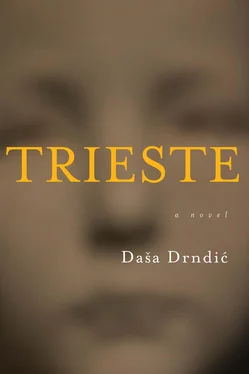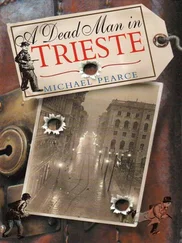I am from Rijeka. My name is Dara Virag. I spent a year at the rice mill. They tortured me terribly. Till this very day I shiver at every sound. The sound of boots on the paving still makes me start and think, They’re coming!
In 1976, before and during the trial of those suspected of committing the crimes at San Sabba, lists of the accused are printed, their biographies are published, or rather summaries of their lives, because many of the people who were milling around the Adriatisches Küstenland between 1943 and 1945 have fat criminal dossiers, interesting and dynamic. Some of them have already been tried in Germany and are doing time for the monstrosities they committed in mental hospitals which were turned into euthanasia centres throughout the Reich, or at the camps of Belzec, Sobibor, Treblinka and beyond, the list is long, there were many concentration camps; some are dead (of old age, illness, execution, suicide), some have been released (most of the accused are released), some escape, some change their identity and vanish without a trace, most of them live here, there, everywhere, until today, until tomorrow. Christian Wirth, Gottfried Schwarz, Franz Reichleitner, Karl Gringers, Alfred Löffler, Karl Pötzinger, Kurt Richter, a crowd of companions, pals, old buddies, rests there in the German war cemetery on the slopes of Monte Baldo in picturesque Costermano, between the eastern shore of Lake Garda and the tourist town of Verona. Surrounded by vineyards and olive groves, the German war cemetery in Costermano lies in the shade of old cypress trees and is described as an attractive site by tourist brochures. There are more than eight hundred German war cemeteries the world over, in which tens of thousands are buried. Costermano is host to 21,972 German graves. So when the trial begins in April 1976 in Trieste against those suspected of being responsible for the crimes committed at the San Sabba rice mill during the German occupation of Italy, the bench for the accused is empty— the bench for the accused is empty —and the trial ends before it starts.
Haya deciphers her past. She builds a file of her past. From a newspaper she cuts out an incomplete list of S.S. men, incomplete because there are more than a hundred of them with some sort of rank and terrible power from 1943 to 1945, when they are dispatched to the Adriatisches Küstenland; more than a hundred of them saunter around the unrealized dreamland of the fictitious Adriatisches Küstenland, yet the list published in the papers gives barely fifty names. Where are the ordinary soldiers? Where are the German police officers? Where are the Ukrainians? Where are the Cossacks? Where are the women and the members of their families who spend their summers and winters on the shore and in the mountains, from 1943 to 1945? Where are the Italians in the service of the Reich? Where are the civilians, the silent observers, the invisible participants in the war? And Here, too, am I, Haya says. This list should be endless. This list is endless, she says.
In the newspaper cutting Haya finds names of people she met, at whose table she ate, with whom she shook hands ( not often, thank God, she adds), and she searches, and researches, and arranges, and stops sleeping, staring instead into the yawning jaws of the Hydra, waiting for the poisonous fumes to spew forth, and Hercules is nowhere to be found. Oh, this eternal repetition, she says, can it be cut short?
Shortcuts, Saba tells Haya’s mother Ada at the Gorizia psychiatric clinic, shortcuts are the shortest way to get from one place to the next. But shortcuts are often impassable, impassable… Saba says.
And Ada, until her death repeats— Behind every name there is a story.

An incomplete list of the former members of Aktion T4 1943 transferred to Trieste and the surrounding areas (O.Z.A.K.)

Gottfried Schwarz, also known as Friedl, S.S.-Hauptscharführer (head squad leader), promoted after Aktion Reinhard to S.S.- Untersturmführer (second lieutenant). Date of birth unknown. Works in mental hospitals — euthanasia centres, at the Grafeneck Castle, in Bernburg and Hadamar as “cremator”, as deputy camp commander at Belzec, as commander of Sobibor. Dispatched to Einsatz R in Trieste in 1943. Killed in Istria. Buried at the German war cemetery in Costermano (grave No. 666).
Gottlieb Hering, born on 2 June, 1887, in Warmbronn, Württemberg, dies in hospital on 9 October, 1945, in unexplained circumstances. Serves for twenty years with Christian Wirth in Stuttgart criminal police, then on Aktion Tiergarten 4. Succeeds Wirth in 1942 as commander of Belzec camp. Like Wirth before him, at Belzec Hering gives himself free rein, indulging a variety of eccentricities, such as shooting at internees while galloping on horseback. About 601,500 people die and are killed at Belzec, most of them Jews. As far as anyone knows, only Rudolf Reder and Chaim Herszman survive. Like Wirth, Hering takes part after 1940 in the Nazi euthanasia programme. While Wirth supervises all six euthanasia centres in the Reich, Hering is in command “only” at Sonnenstein and Hadamer. Promoted to S.S.-Hauptsturm-führer in 1943 and made commander of the San Sabba camp, where he lives in small separate quarters with his secretary at that time, Helena Reigraf from Fellbach, whom he later marries. After Hering is admitted to hospital, Josef Oberhauser takes charge of San Sabba.
Franz Stangl, son of a night watchman, born in Altmünster, Austria, on 26 March, 1908. First works as weaver, then as policeman after 1931, S.S.-Hauptsturmführer (staff sergeant). Member of team that runs T4 euthanasia programme at Hartheim and Bernburg, Germany. Commander of Sobibor and later Treblinka, where he oversees the killing of some 900,000 Jews from 1942 to 1943. Transferred in 1943 to Italy, where he runs the R2 Zone (Udine) and organizes anti-partisan and anti-Jewish operations. The Allies capture him in 1945, but he escapes. With documents he is given by the Red Cross and with money that anti-Semitic, pro-Nazi Bishop Aloïs Hudal provides, Stangl goes to Syria, then to Brazil. Discovered in 1967 working at a Volkswagen factory in Sâo Paulo, arrested and extradited to Germany where he is imprisoned for life. Dies of a heart attack in Düsseldorf prison on 28 June, 1971. Stangl designs and oversees the building of the fake train station at Treblinka in order to deceive future victims. For future “guests”, camp painters paint words of welcome in black lettering on big backdrops: BAHNHOF OERMAJDAN — UMSTEIGEN NACH BIALYSTOK UND WOLKOWYSK (OBERMAJDAN STATION — CHANGE HERE FOR BIAŁYSTOK AND VOLKOVYSK). Signs are erected to indicate a ticket window, first-, second- and third-class waiting rooms, and on the façade of the entire mirage they hang a railway clock. S.S.-guards stride around in uniform, pretending to work for the railway. The fake station is actually the reception for Treblinka camp. Stangl loves horses, so he rides through his camps dressed in white, as he also loves this colour.
Ask away, my conscience is clear. I was commander of Treblinka, yes, but I never had anything to do with killing Jews. My conscience is clear.
How many people were killed in a day?
A transport of thirty freight cars. Three thousand people could be liquidated in three hours. When we worked for fourteen hours, 12,000 to 15,000 people were annihilated.
Читать дальше














